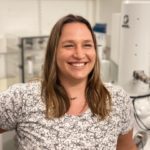Link to Pubmed [PMID] – 32248844
Link to DOI – 10.1186/s13071-020-04026-0
Parasit Vectors 2020 Apr; 13(1): 169
Trypanosoma brucei exhibits a complex life-cycle alternating between tsetse flies and mammalian hosts. When parasites infect the fly, cells differentiate to adapt to life in various tissues, which is accompanied by drastic morphological and biochemical modifications especially in the proventriculus. This key step represents a bottleneck for salivary gland infection.Here, we monitored flagellum assembly in trypanosomes during differentiation from the trypomastigote to the epimastigote stage, i.e. when the nucleus migrates to the posterior end of the cell, by using three-dimensional electron microscopy (focused ion beam scanning electron microscopy, FIB-SEM) and immunofluorescence assays.The combination of light and electron microscopy approaches provided structural and molecular evidence that the new flagellum is assembled while the nucleus migrates towards the posterior region of the body. Two major differences with well-known procyclic cells are reported. First, growth of the new flagellum begins when the associated basal body is found in a posterior position relative to the mature flagellum. Secondly, the new flagellum acquires its own flagellar pocket before rotating on the left side of the anterior-posterior axis. FIB-SEM revealed the presence of a structure connecting the new and mature flagellum and serial sectioning confirmed morphological similarities with the flagella connector of procyclic cells. We discuss the potential function of the flagella connector in trypanosomes from the proventriculus.These findings show that T. brucei finely modulates its cytoskeletal components to generate highly variable morphologies.








